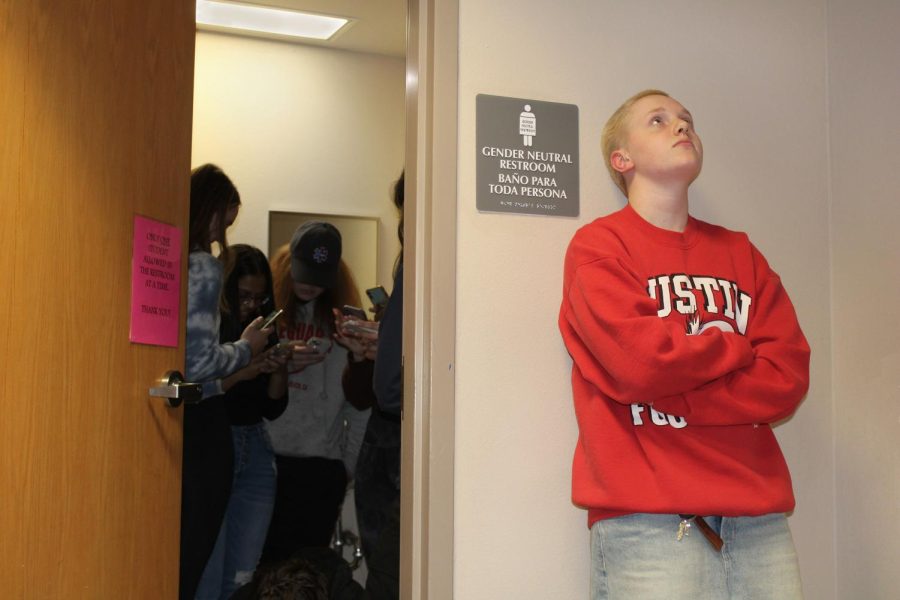Can They Hold It? Trans Students’ Bathroom Options Are Lacking
Sophomore Jude Gorden constantly finds themself waiting for long amounts of time to get into the gender-neutral bathrooms. While these bathrooms were established for trans and nonbinary students, cis students and faculty still use them.
March 13, 2023
Imagine this. You walk into a public restroom, and there’s one handicapped stall and four standard stalls open. If you’re able-bodied, you wouldn’t take the handicapped stall, right? The next person to walk in after you could actually need the bigger stall, so it’s not right to take it just for comfort.
What if that same situation was applied to a single-stalled gender-neutral bathroom and a gendered multi-stalled one? Would you do the same and leave the gender-neutral one for someone who needs it?
Currently, Creek faces that exact issue. Transgender students are late to class and have to use bathrooms they’re not comfortable in because cisgender students and faculty continue to occupy the few gender-neutral bathrooms on campus.
Creek converted some of its faculty restrooms three years ago, creating its first gender-neutral bathrooms. Many students are grateful for this, and this accomplishment shouldn’t be ignored, as many other schools don’t have any at all. However, as more gender non-conforming students raise the need for these resources, the few gender-neutral options that were once enough are now the bare minimum. Creek’s administration needs to be held accountable for their ignorance.
It’s unlikely that gender-neutral bathrooms would have ever been established without the push from Spectrum, Creek’s LGBTQIA+ club. Spectrum’s hounding of Creek administration brought attention to the issue and forced change. If Creek had refused to create a bathroom space for trans students, their facade of inclusivity would have been at risk.
Before Spectrum spoke out about the issue, Creek had the privilege of ignoring the lack of trans resources at their vast campus.
Converting faculty restrooms, Creek’s answer to Spectrum’s request, entailed changing a few bathroom signs – and faculty still used them. This ingenious cop-out allowed Creek to dismiss the issue without making real change. They’ve been coasting on subpar inclusivity for years and will continue to.
Responding to Spectrum’s request as they did helped Creek’s reputation for supporting diverse students, but failed to support the trans students in question. Praising schools for surface-level activism excuses it and leads to more limited effort ‘solutions’ in the future.
The overcrowding of Creek’s all-gender restrooms has caused students to rack up tardies just because there was a line. Trans students who use the gender-neutral restroom as a safe space are forced to tarnish their record by waiting for their preferred bathroom to open up or give themselves dysphoria by using the gendered spaces.
Ideally, resources for trans students would be on par with what’s available for cis students, but Creek’s bathrooms are a clear example that that isn’t the case. Creek’s sorry excuse for gender-neutral bathrooms includes three single-stalled and one newer multi-stalled fully separated from the gendered restrooms.
Even if the bathrooms are open, using a single-stalled restroom shoved in the awkward corner of Creek’s facilities does not comfort trans students, but instead alienates them even further. While the gendered bathrooms are located around high-traffic and easy-to-find areas, the gender-neutral restrooms are a physical afterthought, squeezed into random, empty spaces most students wouldn’t expect to find a bathroom.
I’m not the only one who feels cheated out of this aspect of a normal high school experience. Trans students across Creek feel the same, but are so accustomed to mistreatment that it seems normal.
“The whole point of a gender-neutral restroom is that they make you feel more comfortable and normal…but when you’re walking into a single room, it just feels so strange,” Creek junior Adrian de Araujo said.
All inclusivity has its limitations, and while some may argue Creek admin is doing all they can for trans students, with the campus and funding Creek has, it’s not enough.
Creek’s assistant principal, Kevin Uhlig, claimed that the school’s old campus landlocks them in terms of renovations like new bathrooms. Despite this, the administration recently expanded the Innovation Center and school store. Both these renovations entailed ripping out walls and rearranging rooms, two main factors keeping Creek from installing more genderless bathrooms. Yes, money was given to Creek specifically for these projects, but Creek should also seek out grants for bathroom renovations, not just cosmetic upgrades.
IC Cafe’s expansion was a welcome upgrade, but the space could be utilized more effectively. Even a small portion of the new Innovation Center could have been repurposed to become a multi-stalled genderless bathroom, but instead, trans students are stuck with the poor resources mostly established years ago, with the newest addition added this year.
Realistically, funding for these expensive renovations isn’t always available. A cheaper and simpler solution to this problem is to convert all the gendered restrooms in West and East into gender-neutral ones. It’s a simple fix, and would only entail changing bathroom signs and putting stalls around urinals, and the bathrooms in IC would remain gendered. Even a short-term change to gauge student reactions and usage would benefit Creek’s trans community and could lead to long-term change.
Testing out this idea would help the administration to see how many students would appreciate this change and whether or not it’s worth it to fight for new bathroom funding. Not only would generalizing the bathrooms in West and East provide valuable student feedback, but it would let trans students experience using a community bathroom without mislabeling themselves or making anyone uncomfortable.
While administrators spend money and time upgrading pre-established social spaces, trans Creek students wait for their basic needs to be supported. Currently, the bathrooms available to trans and non-binary students fall significantly short of where they should be, and students suffer because of it.























